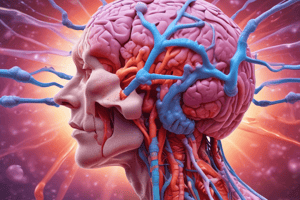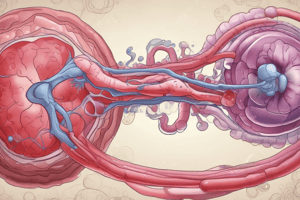Podcast
Questions and Answers
What is the approximate diameter of capillaries?
What is the approximate diameter of capillaries?
- 5 μm (correct)
- 20 μm
- 15 μm
- 10 μm
What type of blood do smaller veins and arteries, arterioles, and venules contain?
What type of blood do smaller veins and arteries, arterioles, and venules contain?
- No blood
- Deoxygenated blood (correct)
- Mixed blood
- Oxygenated blood
What is the function of pericytes in capillaries?
What is the function of pericytes in capillaries?
- Assist in oxygen diffusion
- Secrete hormones
- Resemble smooth muscle cells (correct)
- Produce red blood cells
Where does blood from capillary beds flow into?
Where does blood from capillary beds flow into?
In most forms of inflammation, where does vascular leakage and leukocyte exudation occur preferentially?
In most forms of inflammation, where does vascular leakage and leukocyte exudation occur preferentially?
Flashcards
Capillary diameter
Capillary diameter
Approximately 5 μm
Blood in smaller veins/arteries
Blood in smaller veins/arteries
Deoxygenated
Pericyte function
Pericyte function
Resembles smooth muscle cells.
Capillary bed outflow
Capillary bed outflow
Signup and view all the flashcards
Inflammation location
Inflammation location
Signup and view all the flashcards
Study Notes
Capillary Characteristics
- The approximate diameter of capillaries is 5-10 micrometers.
- Capillaries contain a single layer of endothelial cells.
Blood Vessels and Blood Type
- Smaller veins and arteries, arterioles, and venules contain oxygenated blood.
Pericytes in Capillaries
- The function of pericytes in capillaries is to provide mechanical support and regulate blood flow.
Blood Flow
- Blood from capillary beds flows into venules.
Inflammation Pathophysiology
- In most forms of inflammation, vascular leakage and leukocyte exudation occur preferentially in postcapillary venules.
Studying That Suits You
Use AI to generate personalized quizzes and flashcards to suit your learning preferences.




